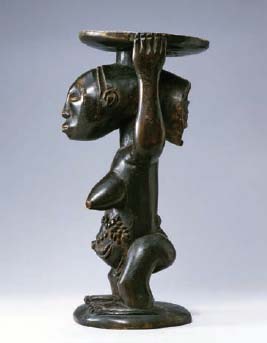| Culture |
Geographic Area |
Art |
| Bamun |
Cameroon |
The art of the Bamun often celebrates the king, especially the king’s throne. A notable example is the throne of the nineteenth-century King Nsangu, whose throne and footstool is richly decorated with beads and shells, indicative of the king’s power. |
| Baule |
Côte d’Ivoire |
The Baule people carve naturalistic, wooden sculptures called waka sran used in ritual dance and healing ceremonies. These sculptures depict frightening spirits, known as asye usu, as if they are beautiful. |
| Dogon |
Mali |
The Dogon are known for their highly stylized, carved images of couples, and the importance of ritual dance in which the participants’ masks, costumes, and art objects play an essential role. |
| Fang |
Southern parts of Gabon and Cameroon |
Ancestor worship is highly significant for the largely nomadic Fang people. They produce portable sculpture, often made of wood, depicting guardian figures called bieri. These stylized figures are child-like in proportion and serve to protect ancestor spirits. |
| Kalahari |
Nigeria |
The Kalabari make ancestral memorial screens known as the nduen fobara.These screens are made of many materials, including fiber and wood, and are used as shrines in honor of important ancestors. They are often meticulously composed of figurative forms and abstract designs. |
| Kota |
Gabon |
The Kota carve highly abstract guardian figures called mbulu ngulu with flat, diamond-shaped bodies, which are polished until reflective. |
| San |
South Africa |
Sometimes referred to as Bushmen, the San are traditionally hunter-gatherers who created rock paintings until the mid-nineteenth century. |
| Yombe |
Congo, Central Africa |
The Yombe are known for their royal maternity figures, known as pfemba. These wooden statues depict pairs of mothers and children and are often decorated with paint and beads. Pfemba sculptures perhaps serve a function in fertility rituals, but their exact use is unknown. |
| Mende |
Sierra Leone |
The Mende are known for Sowei Masks, used by both men and women for ritual dance. The masks have elongated foreheads (symbolizing wisdom) as well as hair attached to the bottom, representative of the feminine ideal. |
| Senufo |
Côte d’Ivoire |
The Senufo make large masks used by male dancers for ritual performances in which they take on the characteristics of spirits and ancestors. They also make costumes and drums, used during important events such as funerals and initiations. |
| Asante |
Ghana |
The Asante are known for carving sculptural figures with flat, exaggerated heads and simplified bodies. The Asante also highly valued gold and used it frequently in their art, especially to glorify the king at court. |

